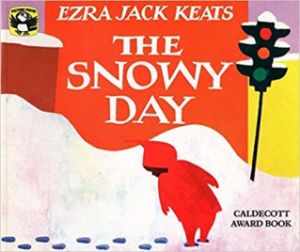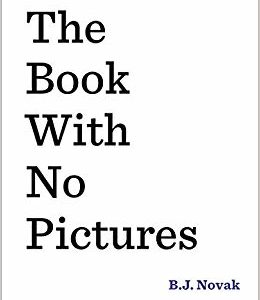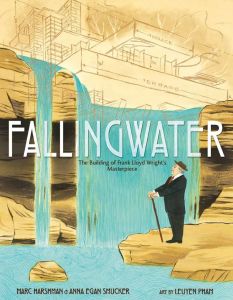“Bring a book to recommend,” participants in Read Aloud’s annual conference were instructed. Then at a good pausing point (or technical glitch, because books don’t glitch, right?) a volunteer would offer a quick show-and-tell. This issue’s book reviews include some of those favorites from around the state:
 1. The Book with No Pictures by B.J. Novak. You may know the author better as Ryan from the TV show “The Office.” Don’t be daunted by the hilarious video online of Novak reading it to a school in New York. But be warned. Here’s a sample: “Everything the words say, the person reading the book has to say.
1. The Book with No Pictures by B.J. Novak. You may know the author better as Ryan from the TV show “The Office.” Don’t be daunted by the hilarious video online of Novak reading it to a school in New York. But be warned. Here’s a sample: “Everything the words say, the person reading the book has to say.
“No matter what.”
Young listeners wisely get the foreshadowing here and anticipate with giggles.
 2. The Big Jump and Other Stories by Benjamin Elkin. This one, originally published in 1958, was recommended by Berkeley County volunteer Casey Wilson because it is one of his wife’s favorites. He read the first of the three stories in the book to a first-grade class, and then closed the book.
2. The Big Jump and Other Stories by Benjamin Elkin. This one, originally published in 1958, was recommended by Berkeley County volunteer Casey Wilson because it is one of his wife’s favorites. He read the first of the three stories in the book to a first-grade class, and then closed the book.
A student raised his hand and said, “There are more pages in that book.”
Caught holding out on them, Wilson re-opened the book and read all three stories to the class in that one sitting.
“It’s as different from what’s coming out that’s new and contemporary as it can be, but the kids love it. Don’t be hesitant to pull out the old-timers,” he said.
 3. Caps for Sale by Esphyr Slobodkina. Speaking of old-timers, this folktale was first published as the beloved picture book by an avant-garde artist in 1940. It has sold millions and makes a great board book because of the repetitive language suited to small children. If you read it, though, make sure you know what monkey noise you’re going to make when the time comes.
3. Caps for Sale by Esphyr Slobodkina. Speaking of old-timers, this folktale was first published as the beloved picture book by an avant-garde artist in 1940. It has sold millions and makes a great board book because of the repetitive language suited to small children. If you read it, though, make sure you know what monkey noise you’re going to make when the time comes.

4. What Do You Do with an Idea? by Kobi Yamada and illustrated by Mae Besom. A national bestseller this all-ages story and light, inviting drawings explore something anyone can recognize — what do you do with that idea? Sequels include What Do You Do with a Problem? and What Do You Do with a Chance?
 5. Counting on Katherine: How Katherine Johnson Saved Apollo 13 by Helaine Becker and illustrated by Dow Phumiruk. This beautiful new picture book traces West Virginia’s recently discovered hero Katherine Johnson, of Greenbrier County, educated at West Virginia State University and WVU, who then worked quietly behind the scenes at NASA doing the math that made space travel possible. It’s aimed at younger students, but it has something to inform and inspire all ages.
5. Counting on Katherine: How Katherine Johnson Saved Apollo 13 by Helaine Becker and illustrated by Dow Phumiruk. This beautiful new picture book traces West Virginia’s recently discovered hero Katherine Johnson, of Greenbrier County, educated at West Virginia State University and WVU, who then worked quietly behind the scenes at NASA doing the math that made space travel possible. It’s aimed at younger students, but it has something to inform and inspire all ages.

6. Henry Builds a Cabin by D.B. Johnson. This is the first in a short series of picture books drawing on specific stories and imagery of Henry David Thoreau. This Henry is a bear who sets about building a cabin in the woods. The sentences are simple enough for little ones to follow, but the book is even better in fourth and fifth grades, where students kick off discussion with “Why is he doing that?” Or someone insists that no one can build a house for 28 dollars, 12 and a half cents, and we discover the word inflation.
 7. Cendrillon by Robert D. San Souci and illustrated by Brian Pinkney. This is another picture book that grows with the students. It’s the Cinderella story, so easily recognizable, but set in the French West Indies, with all the color, imagery and a peppering of French Creole language. Also, it is told from the point of view of the Fairy Godmother, or nannin’.
7. Cendrillon by Robert D. San Souci and illustrated by Brian Pinkney. This is another picture book that grows with the students. It’s the Cinderella story, so easily recognizable, but set in the French West Indies, with all the color, imagery and a peppering of French Creole language. Also, it is told from the point of view of the Fairy Godmother, or nannin’.
 8. Alvin Ho: Allergic to Girls, School and Other Scary Things by Lenore Look and illustrated by LeUyen Pham. A chapter book, this features second-grader Alvin Ho, aka his superhero alter-ego Firecracker Man, who does everything you would expect, except that as soon as he steps off the bus at school he can’t talk. The characters inspire laughs and compassion in listeners. It’s not too young for third grade, where students begged for the next one in the series.
8. Alvin Ho: Allergic to Girls, School and Other Scary Things by Lenore Look and illustrated by LeUyen Pham. A chapter book, this features second-grader Alvin Ho, aka his superhero alter-ego Firecracker Man, who does everything you would expect, except that as soon as he steps off the bus at school he can’t talk. The characters inspire laughs and compassion in listeners. It’s not too young for third grade, where students begged for the next one in the series.
 9. Monsters in West Virginia by Rosemary Ellen Guiley. There is something even more suspenseful about allegations of monsters and fantastic beasts just out of sight, if the places they were supposedly spotted are places you know — Grafton, Point Pleasant, Braxton County, for example. A good lure for older listeners.
9. Monsters in West Virginia by Rosemary Ellen Guiley. There is something even more suspenseful about allegations of monsters and fantastic beasts just out of sight, if the places they were supposedly spotted are places you know — Grafton, Point Pleasant, Braxton County, for example. A good lure for older listeners.
 10. The Miraculous Journey of Edward Tulane by Kate DiCamillo. “I love the connections we can make between how the author explored different kinds of love, friendship, family love, betrayal, all of these rich ideas and plot twists and things that we can look at together when we read those books,” said Christy Schwartz, literacy specialist with the West Virginia Department of Education’s Campaign for Grade Level Reading.
10. The Miraculous Journey of Edward Tulane by Kate DiCamillo. “I love the connections we can make between how the author explored different kinds of love, friendship, family love, betrayal, all of these rich ideas and plot twists and things that we can look at together when we read those books,” said Christy Schwartz, literacy specialist with the West Virginia Department of Education’s Campaign for Grade Level Reading.
“There’s a really powerful moment at the end. Every time my students saw me tear up at the end, they thought, ‘Wow.’ They fell in love with the characters, with the author, and they tended to read more books by that author.” This is another one for upper elementary students.
Looking for your next Read Aloud hit? Need to freshen your repertoire?
Scroll through and click around our helpful booklists.








































 1. The Book with No Pictures by B.J. Novak. You may know the author better as Ryan from the TV show “The Office.” Don’t be daunted by the hilarious video online of Novak reading it to a school in New York. But be warned. Here’s a sample: “Everything the words say, the person reading the book has to say.
1. The Book with No Pictures by B.J. Novak. You may know the author better as Ryan from the TV show “The Office.” Don’t be daunted by the hilarious video online of Novak reading it to a school in New York. But be warned. Here’s a sample: “Everything the words say, the person reading the book has to say. 2. The Big Jump and Other Stories by Benjamin Elkin. This one, originally published in 1958, was recommended by Berkeley County volunteer Casey Wilson because it is one of his wife’s favorites. He read the first of the three stories in the book to a first-grade class, and then closed the book.
2. The Big Jump and Other Stories by Benjamin Elkin. This one, originally published in 1958, was recommended by Berkeley County volunteer Casey Wilson because it is one of his wife’s favorites. He read the first of the three stories in the book to a first-grade class, and then closed the book. 3. Caps for Sale by Esphyr Slobodkina. Speaking of old-timers, this folktale was first published as the beloved picture book by an avant-garde artist in 1940. It has sold millions and makes a great board book because of the repetitive language suited to small children. If you read it, though, make sure you know what monkey noise you’re going to make when the time comes.
3. Caps for Sale by Esphyr Slobodkina. Speaking of old-timers, this folktale was first published as the beloved picture book by an avant-garde artist in 1940. It has sold millions and makes a great board book because of the repetitive language suited to small children. If you read it, though, make sure you know what monkey noise you’re going to make when the time comes.
 5. Counting on Katherine: How Katherine Johnson Saved Apollo 13 by Helaine Becker and illustrated by Dow Phumiruk. This beautiful new picture book traces West Virginia’s recently discovered hero Katherine Johnson, of Greenbrier County, educated at West Virginia State University and WVU, who then worked quietly behind the scenes at NASA doing the math that made space travel possible. It’s aimed at younger students, but it has something to inform and inspire all ages.
5. Counting on Katherine: How Katherine Johnson Saved Apollo 13 by Helaine Becker and illustrated by Dow Phumiruk. This beautiful new picture book traces West Virginia’s recently discovered hero Katherine Johnson, of Greenbrier County, educated at West Virginia State University and WVU, who then worked quietly behind the scenes at NASA doing the math that made space travel possible. It’s aimed at younger students, but it has something to inform and inspire all ages.
 7. Cendrillon by Robert D. San Souci and illustrated by Brian Pinkney. This is another picture book that grows with the students. It’s the Cinderella story, so easily recognizable, but set in the French West Indies, with all the color, imagery and a peppering of French Creole language. Also, it is told from the point of view of the Fairy Godmother, or nannin’.
7. Cendrillon by Robert D. San Souci and illustrated by Brian Pinkney. This is another picture book that grows with the students. It’s the Cinderella story, so easily recognizable, but set in the French West Indies, with all the color, imagery and a peppering of French Creole language. Also, it is told from the point of view of the Fairy Godmother, or nannin’. 8. Alvin Ho: Allergic to Girls, School and Other Scary Things by Lenore Look and illustrated by LeUyen Pham. A chapter book, this features second-grader Alvin Ho, aka his superhero alter-ego Firecracker Man, who does everything you would expect, except that as soon as he steps off the bus at school he can’t talk. The characters inspire laughs and compassion in listeners. It’s not too young for third grade, where students begged for the next one in the series.
8. Alvin Ho: Allergic to Girls, School and Other Scary Things by Lenore Look and illustrated by LeUyen Pham. A chapter book, this features second-grader Alvin Ho, aka his superhero alter-ego Firecracker Man, who does everything you would expect, except that as soon as he steps off the bus at school he can’t talk. The characters inspire laughs and compassion in listeners. It’s not too young for third grade, where students begged for the next one in the series. 9. Monsters in West Virginia by Rosemary Ellen Guiley. There is something even more suspenseful about allegations of monsters and fantastic beasts just out of sight, if the places they were supposedly spotted are places you know — Grafton, Point Pleasant, Braxton County, for example. A good lure for older listeners.
9. Monsters in West Virginia by Rosemary Ellen Guiley. There is something even more suspenseful about allegations of monsters and fantastic beasts just out of sight, if the places they were supposedly spotted are places you know — Grafton, Point Pleasant, Braxton County, for example. A good lure for older listeners. 10. The Miraculous Journey of Edward Tulane by Kate DiCamillo. “I love the connections we can make between how the author explored different kinds of love, friendship, family love, betrayal, all of these rich ideas and plot twists and things that we can look at together when we read those books,” said Christy Schwartz, literacy specialist with the West Virginia Department of Education’s Campaign for Grade Level Reading.
10. The Miraculous Journey of Edward Tulane by Kate DiCamillo. “I love the connections we can make between how the author explored different kinds of love, friendship, family love, betrayal, all of these rich ideas and plot twists and things that we can look at together when we read those books,” said Christy Schwartz, literacy specialist with the West Virginia Department of Education’s Campaign for Grade Level Reading.

